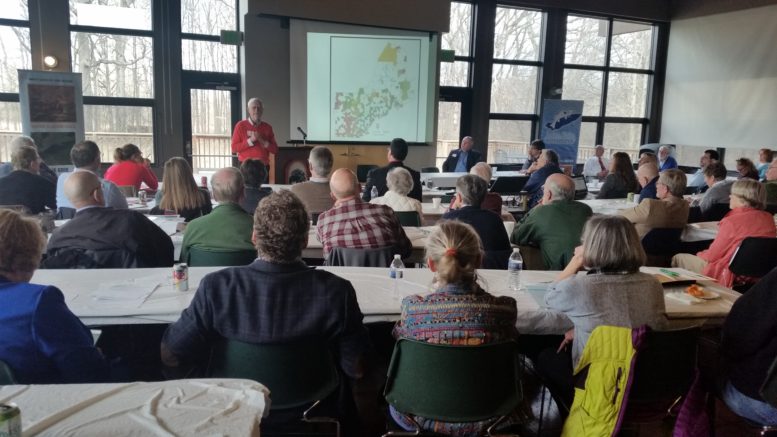By JAN LARSON McLAUGHLIN
BG Independent News
After Lake Erie turned green with algal blooms in 2014, and local residents were cautioned not to consume tap water from Toledo, officials rushed to make changes to keep this crisis from happening again.
But too little has been accomplished, and the threat still looms over the lake as summer approaches again, according to a Waterkeepers conference held Friday at W.W. Knight Preserve near Perrysburg.
Speakers blamed a good portion of the problem on the amount of manure being created, and the amount of fertilizer being spread on fields.
“We are producing more shit than we have land to put it on,” speaker Dr. Earl Campbell, of Perrysburg, said during a break in the program.
“We’re not understanding the source and the amounts,” of the phosphorous from manure and fertilizers running into the lake, said Sandy Bihn, executive director of the Waterkeepers organization. “We’re not following the Clean Water Act.”
Two speakers from the agricultural community praised farmers for trying to reduce runoff, but also pointed fingers at them for not doing enough.
Estimates vary, but agricultural runoff is blamed for 50 to 80 percent of the nutrients creating harmful algae in Lake Erie. The problem has worsened as small farms have been replaced by large farms with more concentrated livestock operations, according to Ron Wyss, a Hardin County farmer.
The building of Concentrated Animal Feeding Operations, sometimes referred to as mega-farms, has led to over application of manure on fields nearest the CAFOs.
Recent studies have shown that less phosphorous from fertilizers produces comparable or better yields, yet some farmers continue to apply more than necessary to their fields, Wyss said.
“This is America, and the more, the better,” he said.
“The bottom line is, 20 parts per million is all you need to grow your crop,” Wyss said, though many farmers double that amount. “Forty parts per million is way over what we need to grow most crops.” Regulations actually allow much, much more, up to 150 parts per million.
Wyss compared the soil to a sponge. When it gets saturated with water, the phosphorous seeps out and heads toward the lake.
“We’ve been filling that sponge for a long time,” he said.
Wyss estimated that $4 million of phosphorous is lost down the Maumee River a year.
The problem is worsened by the frequent heavy rains, attributed to climate change, he added. Those downpours cause nutrient runoffs from fields and wastewater plant overflows, which fuel the harmful algae. He estimated 10 percent of the rainfalls create 65 percent of the discharge.
State legislation is now in place limiting the amount and the timing when fertilizers and manure can be placed on fields, according to Laura Johnson, of Heidelberg University. Application is no longer allowed on frozen fields.
“Ohio is working on a plan to meet the reduction targets,” Johnson said.
Bill Myers, of the Lucas County Farm Bureau, said two positive steps have been taken, with federal funds helping farmers plant cover crops, and the restrictions on fertilizing frozen ground.
“I don’t know why it took legislation to make that happen,” Myers said.
More farmers are also injecting the fertilizer into the soil, which reduces runoff, he said.
However, Wyss said the rules are interpreted loosely. “There are still big loopholes.”
Myers also spoke of the need for farmers to use less fertilizer. The 1970 rules being used are long outdated, he said. People often ask, he said, why the algae is a problem now, when farmers have been applying fertilizer to their fields for years.
“Why didn’t this happen years ago, if it’s all coming from ag?” he said.
Myers shared a theory that is gaining support. When the Clean Air Act was passed, it focused on taking acid rain from the air. The efforts worked, and in the process it changed the soil, making it so phosphorous passes through it more easily.
“It’s an unintended consequence of what we thought was going to be good,” he said.
The result is that the old standards of 40 parts per million of phosphorous needed on fields is double what is actually needed now.
“We need to change the amount of nutrients it takes to raise crops,” Myers said.
Wyss offered the following common sense recommendations to reduce phosphorous flowing into Lake Erie:
- Reduce the permitted 150 parts per million phosphorous allowed on fields.
- Increase organic matter, cover crops, no till.
- Inject the nutrients, rather than spreading them on top of soil.
- Avoid fall and winter applications.
- Test soils, so phosphorous is not applied where it is not needed.
Small changes can reduce runoff, save farmers money, and increase production, according to Wyss.
The agricultural community is no longer denying its role in the algae problem, he said.
“The answer from ag now is ‘we’ve got to do our part,’” Wyss said. “The good news for the future is, we have a highly educated group of farmers,” willing to be part of the solution.

